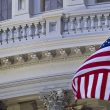Objects in the Rear View Mirror May Appear Closer Than They Are: A Look Back at the 1990s
by Liz Ann Sonders, Senior Vice President, Chief Investment Strategist, Charles Schwab & Co., Inc.
March 17, 2014
Key Points
- There are many striking similarities between today's environment and the mid-1990s; albeit with a few notable differences as well.
- The similarities span from economic, to political, to monetary to the market.
- Assuming the patterns continue it could be an ideal environment for the market and economy … assuming it doesn't end with a speculative top, like in 1999-2000.
In many recent written reports and videos, I've touched on- in passing but not in detail- the similarities between today's market environment and the one in the mid-1990s. This report will do that in detail. It's longer than usual, for which I apologize, but a lot of it is charts.
Before I get to the details, I want to point out that the comparison to the 1990s has been discussed in recent reports by BCA Research, ISI Group, and Ed Yardeni, among others; so this is not a controversial perspective; but an interesting one nonetheless.
Let's start with summary lists of the similarities and differences.
Major similarities:
- Post-financial crisis period (S&L crisis then, housing crisis now)
- Slow, "jobless" economic recovery
- Similar stage within economic cycle
- Extremely easy monetary policy, but "normalization" beginning
- Low inflation
- Freer trade (NAFTA then, WTO pact now)
- Today's eurozone = 1990s Japan
- Government shutdowns (1995-1996 and 2013)
- Midterm election year (1994 and 2014)
- Rapidly improving federal budget deficit
- Minimum wage hike
- Technology revolution
- Rising valuations from depressed levels
- US market outperforming emerging markets (EM)
- Record-high margin debt levels
- Rising volatility
- Increasing equity mutual fund inflows
Major differences:
- Quantitative easing (QE) = huge uncertainty/uncharted waters
- Profit margins are more elevated today
- Income inequality is greater today
- More varied global/geopolitical concerns today
- "Muscle memory" in full force today thanks to recent events: tech crash, 9/11, housing crash
In keeping with the "a picture paints a thousand words" view, below is a series of charts that highlight the many similarities between today's environment and that of the mid-1990s. I've shown the general ranges of comparison with my subjective shading in the charts. We'll start with the economy, move on to Washington and conclude with the stock market.
Economic similarities
Partly due to the characteristics of a post-financial crisis era, the mid-1990s was considered the first "jobless" recovery, although it followed a much less-severe recession than the current "jobless" recovery. See the monthly non-farm payrolls chart below.
Another Jobless Recovery?
Source: Department of Labor, FactSet, as of February 28, 2014.
Additional economic similarities include the trends in average hourly earnings, a minimum wage hike (being considered today), low inflation and flat-but-possibly-troughing real personal consumption expenditures. The latter is the consumer spending metric within gross domestic product (GDP), and can be seen in the chart below.
Consumption to Pick Up?
Source: Bureau of Economic Analysis, FactSet, as of January 31, 2014.
What you can see above is the weakening in consumption that followed the V-shaped surge coming out of the 1990-1991 and 2007-2009 recessions. Like recently, there was a period of leveling off in the mid-1990s before consumption growth picked back up into the 2000 peak.
Monetary policy is obviously extremely easy today, as it was in the mid-1990s (albeit without QE and at a higher absolute level).
Very Easy Monetary Policy
Source: FactSet, Federal Reserve, as of March 14, 2014.
The Federal Reserve was the first major global central bank to begin tightening monetary policy in 1994, while the German Bundesbank and the Bank of Japan were still easing. Today, with the Fed having begun tapering QE, we are again out in front of most other global central banks (the Bank of England being an exception).
Related to still-easy monetary policy as well as freer global trade and weaker emerging markets growth; inflation is low with limited risk of a major spike from these levels, even if wage growth picks up from here (like it did in the mid-1990s).
Better Wages, But Still-Low Inflation?
Source: Department of Labor, FactSet, as of February 28, 2014.
There is a tendency of wage growth to accelerate in the latter half of an economic cycle. Clearly, the turn up this time is occurring from much lower levels courtesy of the "great recession." For what it's worth, in the past three cycles, the 4% level was important both in signaling the finale of the cycle and rising inflation/tighter monetary policy.
Washington's similarities
Washington and politics bring us another set of similarities via both the government shutdowns (twice in the mid-1990s and again last year), and in their wake, the improvement to the deficit, as you can see in the charts below.
Deficit Improving
Source: FactSet, as of February 28, 2014.
Staying on the Washington theme, it's a midterm election year this year, as it was in 1994. As we've been detailing over the past several months, there is a strong (well, perfect since 1962) historical tendency for the stock market to give back a decent amount in a typically-first half corrective phase. The good news caveat is that there has been an equally strong/perfect historical tendency for subsequent major rallies.
Midterm Election Years' Repetitive Patterns
Source: Strategas Research Partners LLC, as of March 14, 2014.
To date this year, the S&P 500 suffered only a 6% decline from mid-January through early-February. We've been suggesting there could be more to come; but if not, it would be the mildest midterm election year pullback since 1962. But note that the pullback in 1994 was also historically quite mild (as was its subsequent rally).
Market similarities
With that as a transition, let's now conclude with some stock market comparisons. The first is how our stock market is behaving relative to the beleaguered emerging markets (EM). EMs are now facing long-term structural problems amid rolling currency crises; not all that dissimilar to the Asian currency crisis/Russian default/LTCM failure era of the late-1990s.
As you can see in the chart below, we appear to be in the early stages of a meaningful rebound in relative US market outperformance, similar to what unfolded in the mid-1990s.
US Over EM Again
Source: FactSet, as of March 14, 2014.
I also put in a bullet on the similarities list above suggesting today's eurozone is the 1990s Japan. This was detailed in a January BCA report: "In the first half of the 1990s, Japan was struggling with debt deflation. Economic growth in Japan fell apart, profits collapsed and the economy was marching toward sustained price deflation…Today's eurozone is yesterday's Japan: excluding Germany, the rest of the eurozone economy remains mired in stagnation."
Stress in EM has been a contributing factor behind the recent uptick in volatility, but I believe we may be entering a period similar to the mid-to-late 1990s, when the stock market and volatility both rose for an extended period (the only time in history). As most know (and you can partly see in the chart below), the two generally move inversely.
Market and Volatility to Rise in Tandem?
Source: FactSet, as of March 14, 2014.
A statistic that's been receiving a lot of attention lately is the record level of margin debt. However, not only is margin debt a coincident, not leading, market indicator; 25% of all monthly readings in margin debt since 1980 have been record levels, according to Bespoke Investment Group. In other words, record levels of margin debt are fairly common.
Margin Debt at Record … Again
Source: FactSet, Ned Davis Research, Inc. (Further distribution prohibited without prior permission. Copyright 2014© Ned Davis Research, Inc. All rights reserved.), as of January 31, 2014.
As you can see in the chart above, for much of the 1990s, margin debt was at the very high end of its "bearish-to-bullish" range.
With margin debt high, it's no surprise that investors appear to be at least falling in like again with the stock market, which can be seen looking at equity mutual fund flows. Retail flows into US stocks have only just begun to move into positive territory.
Equity Fund Flows Picking Up
Source: FactSet, Investment Company Institute (ICI), as of January 31, 2014.
I'll conclude on valuation, which also bears a striking similarity to the era of the mid-1990s; when P/Es were coming up off fairly depressed post-1990, post-S&L crisis levels. What we shouldn't wish for is the valuation spike into bubble territory that occurred in 1999-2000.
P/E Up But Still Reasonable
Source: FactSet, Standard & Poor's, as of March 14, 2014.
In sum, although there are differences, there are many more similarities between today and the mid-1990s in terms of both the economic and market cycles. It's a signal we are likely in the more mature phase of both; a phase when individual investor participation heats up and when the economy more clearly moves from recovery to expansion. But a note of caution: as tempting as it is to pine for the late-1990s and hope for a repeat over the next few years, remember that ultimate melt-up did not end well at all. A better scenario this time would be for the market to continue pacing the mid-1990s market, but without the blow-off top in 1999-2000.
Copyright © Charles Schwab & Co., Inc.













